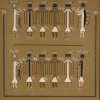Chinle, Arizona
A community located a mile west of the mouth of Canyon de Chelly on the Navajo reservation in northeastern Arizona. In Navajo, the place is known as Ch’ínílį or “Water Outlet." A site of great spiritual significance, Canyon de Chelly is considered the heart of the Navajo people and was the site of their final resistance against demands from the U.S. government to relocate during the 19th century. Eventually succumbing to the privations and difficulties of what today would be understood as guerrilla warfare, it was at Chinle that the Navajo people finally surrendered to Kit Carson in 1864. After the forced march to and detainment at Bosque Redondo in southeastern New Mexico, the Navajo were permitted to return to their homelands, including Canyon de Chelly. Because of the fertile agricultural fields and prime grazing lands in Chinle Valley, Chinle became the hub of a trading network, and a trading post was established there in the 1880s. Chinle remains a vital cultural and economic center for the Navajo, as well as a popular tourist spot for visitors.










